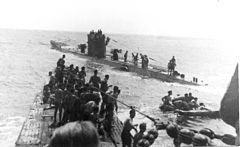Laconia Incident

U-156 and U-506 with ship-wrecked Laconia crew
|
|
| Date | 12–24 September 1942 |
|---|---|
| Location | off the coast of West Africa |
| Type | Torpedo attack and subsequent rescue attempts |
| Participants | Royal Navy, Kriegsmarine, US Army Air Force, Vichy France |
| Outcome | Laconia Order |
| 1,619 dead, 1,113 rescued | |
The Laconia incident was a series of events surrounding the sinking of a British troopship in the Atlantic Ocean during World War II and an attack on the subsequent rescue attempts. On 12 September 1942, RMS Laconia carrying some 2,732 crew, passengers, soldiers and prisoners of war (POWs), was torpedoed and sunk by the German U-boat submarine U-156 off the coast of West Africa. Operating partly under the dictates of the old prize rules, the U-boat commander, Korvettenkapitän Werner Hartenstein, immediately commenced rescue operations. U-156 broadcast their humanitarian intent on open radio channels to all Allied forces in the area, and were joined by the crews of several other U-boats in the vicinity.
After surfacing and picking up survivors, who were accommodated on the foredeck, U-156 headed on the surface under Red Cross banners to rendezvous with Vichy French ships and transfer the survivors. En route, the U-boat was spotted by a United States Army Air Forces (USAAF) B-24 Liberator bomber. The pilots, having reported the U-boat's location, intentions, and the presence of survivors, were then ordered to attack the sub. The B-24 killed dozens of Laconia's survivors with bombs and strafing attacks, forcing U-156 to cast their remaining survivors into the sea and crash dive to avoid being destroyed. The pilots of the B-24 mistakenly reported that they had sunk U-156, and were awarded medals for their bravery.
...
Wikipedia
